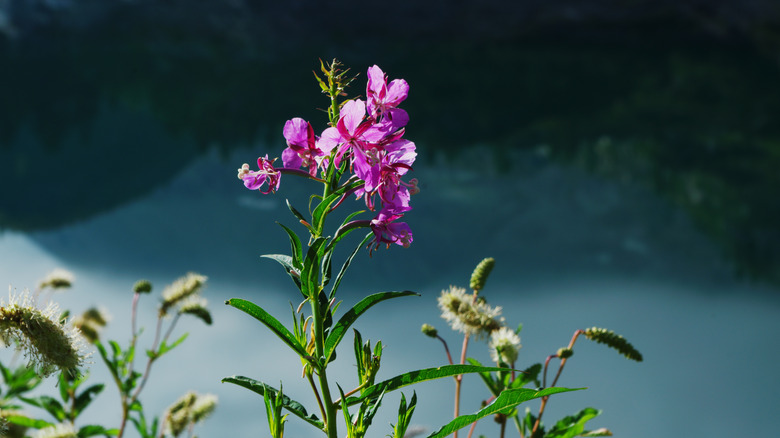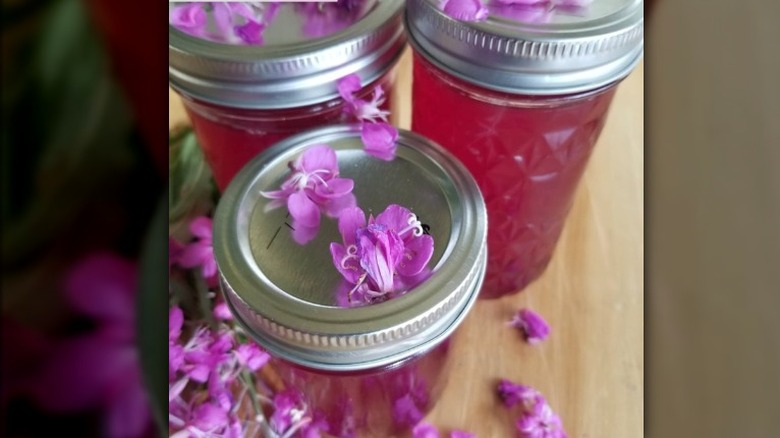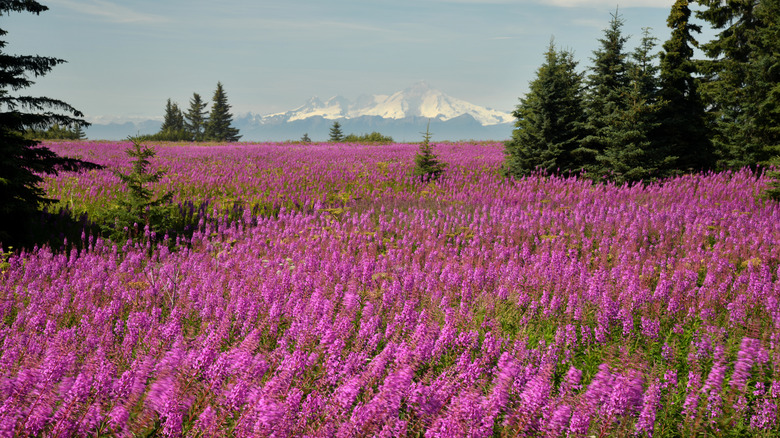The Vibrant Pink Jelly That Comes From A Truly Unique Plant
Have you ever walked through the forest after a wildfire? It's bleak to behold the sight — and smell — of skeletal trees and ground-cover plants blackened to a crisp and covered in ash. But after some time has passed, new life begins to emerge. The so-called "pioneer" or "post-disturbance" species of ferns, moss, and mushrooms that sprout from the scorched soil are often joined by another colorful plant: fireweed.
The aptly named wildflower, known for its bright magenta petals, commonly grows after forest fires, but it also blooms annually in northern climates around the world — including Alaska and parts of the Pacific Northwest – from June through September. Not only is it pretty to look at, but its flower is also edible. The small leaves can be eaten raw, tossed in a salad, or sautéed. Some even call fireweed shoots "the asparagus of the North."
The real magic, though, is in the petals. Alaskans in particular have made a tradition of harvesting its flowers for jelly in the summertime.
A colorful summer condiment
The best time to harvest fireweed petals for jelly is when the plant is young. Since fireweed blooms from the bottom up, a tall and fully blossomed stem is a sign that jelly season has come and gone. Travel blogger Andrea Kuuipo, who grew on Denaʼina land in Anchorage, Alaska, sources fireweed in July and August, when the flowers are about two-thirds of the way up the stalk.
Since she's only interested in making jelly (fireweed is also used to make honey and syrups), she makes sure to only pick the fresh petals, leaving the seed pods, shoots, leaves, "or anything green" behind. Once she has about eight packed cups of petals, she takes her lot home, rinses them, boils the petals with lemon juice (the more you add, the lighter your jelly will be) for 10 minutes, and strains it into a tea.
She then adds 2 packages of powdered pectin and 1 cup of sugar to the mix, boils it for a minute more, kills the heat, and ladles the jelly — which sets quickly — into sterilized canning jars. Unopened jars of fireweed jelly will last up to two years in a cool, dark place. Once opened, it'll last for about three months.
Fireweed's healing properties
If you're not into jelly or your supermarket is fresh out of pectin packets, you should definitely still consider taking home some fireweed if you happen across it on a hike. According to Native Memory Project, dried fireweed leaves can be used to make Ivan Chai, a healing tea that can reduce inflammation. Thanks to the plant's antioxidants, fireweed has also been known to treat fungal, yeast, and bacterial infections. It also contains bioflavonoids and vitamins C and A.
A Joybilee Farm recipe for Ivan Chai lays out the process in five steps: harvesting, wilting, rolling, oxidizing and fermenting, and drying. It doesn't require any special equipment, but it takes time. Once the leaves are dried and properly stored, they'll last as long as any other dried tea. Of course, if you're not up to the task, you can always opt for buying fireweed tea online.


